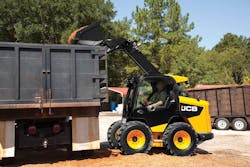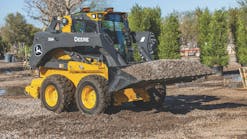JCB intends for its Savannah, Ga., manufacturing facility to be “the skid steer capital of the world,” sales support manager Larry Ashley told media and dealers during its launch of the next-generation skid steer and compact loader line.
Of the 18 models that will eventually be produced, seven are available immediately with the remaining 11 to be online June 2011. The UK-based manufacturer completely revamped its manufacturing facility to focus solely on the world-wide supply of small loaders: design, engineering and manufacturing, CEO/president John Patterson said.
“North America generates 60 percent of the worldwide demand for skid steers and compact track loaders, so developing and producing the new generation of machines in Savannah makes perfect sense and has enabled us not only to meet the unique needs of the North American market but also develop a machine range that will have universal appeal,” Patterson said.
The first seven models are vertical-lift machines, including four wheeled—models 260, 280, 300 and 330—and three tracked—models 260T, 300T and 320T. Rated operating capacities range from 2,600 to 3,295 pounds for the wheeled models, and 3,994 to 4,573 pounds for the tracked units. JCB had not previously fielded a vertical-lift unit, and Ashley says the machines represent 70 percent of market volume.
“Our current lineup covers 53 percent of the market,” Ashley said. “The new generation equals 97 percent of the market.”
All 18 loaders retain JCB’s single-boom PowerBoom configuration, which has been reengineered to contain “20 percent more steel than the competition has in two arms,” Ashley said. JCB touts the single-boom design as safer than the conventional two-arm design. With the single boom on the right side of the machine, a left-side entry door allows the operator to enter and exit the machine clear of any attachments and loader arm.
Serviceability has been SAE audited, Ashley said, and is 24 percent better than the rest of the market. Key to this is a simplified design that eliminates 38 parts and the use of O-ring face seal hydraulic fittings. A new tilting cab provides ample access to power train and hydraulic components. Rear service door provides access to the engine and daily checkpoints, and a top-opening hood allows access to the radiator.
The cab is 17 percent larger than previous models and because it is isolated, sealed and pressurized is 85 percent quieter, registering 76dBa.
Ashley said the units will offer 15 percent lower owning and operating costs, and will deliver 16 percent better fuel-efficiency.
Patterson expects the Savannah plant to produce up to 2,000 a year by the end of 2011. Although he couldn’t be specific, Patterson said about one-third of the loaders produced by JCB might wind up in the Volvo distribution channel as part of the agreement between the two multinationals. The design will be identical, Patterson said, with the Volvo units carrying Volvo-branded seats, instrumentation, colors and decals.





